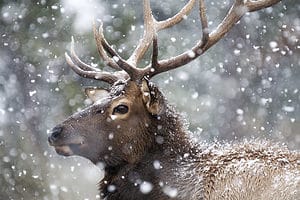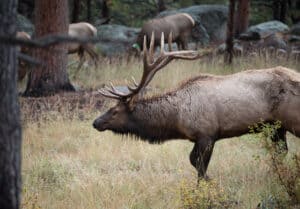Elk, or wapiti, is the second-largest species within the deer family. These light-colored deer can reach up to 9 feet tall with antlers and weigh between 300 and 1,100 pounds. These majestic creatures were once across much of North America but were killed off and driven to remote locations.
Today, you can find most of their population on the western side of the country, including Texas. Discover the history of elk in Texas, how many are left, and where they live. Plus, learn about elk hunting regulations in the Lone Star State.
History of Elk in Texas

Elk are native to Texas and once lived on the plains along with bison, antelope, and deer.
©Tom Tietz/Shutterstock.com
Many believe that Texas’s native elk only existed in a small region of the Guadalupe Mountains, but they originally lived on the plains along with bison, antelope, and white-tailed deer. The earliest record of humans encountering elk in Texas was in 1601.
The governor of New Mexico, Don Juan de Oñate, explored the land northeast of Santa Fe. He came across these creatures drinking from a river and described them as deer-like and being “as large as large horses.” Between 1600 and 1900, many accounts place elk from the Panhandle to the Rio Grande Valley, confirming that elk are native to Texas. Further, rock art in the Lower Pecos Canyonlands depicts elk from over 4,000 years ago.
At some point in history, sport and commercial hunting led to the near-extinction of elk. And by the twentieth century, native elk numbers had dwindled significantly across the state. In 1928, 44 elk from the Black Hills of South Dakota were released in McKittrick Canyon in the Guadalupe Mountains. This species multiplied rapidly and soon inhabited the mountain ranges. In the early 1990s, migratory elk formed herds in the nearby mountains of Glass, Wylie, Davis, and Eagle. Currently, elk in Texas are free-ranging, and some may thrive in high fence ranches.
Where Do Elk Live in Texas?

Elk live in West Texas in five mountain ranges: Guadalupe, Glass, Wylie, Davis, and Eagle.
©Wesley Aston/Shutterstock.com
Elk in West Texas exist in five herds; Guadalupe Mountains, Glass Mountains, Wylie Mountains, Davis Mountains, and Eagle Mountains. Those counties consist of Culberson, Brewster, Jeff Davis, and Hudspeth. People spotted elk in the Texas Panhandle near Dallam County in recent years.
Before humans inhabited the majority of the country, elk would inhabit the plains in the winter and forested areas in the summer. They would freely migrate from one habitat to another every season. Because of economic and agricultural activities, elk are forced to stay in mountainous regions yearlong. A lack of geographic range, especially during the winter, can create challenges with increasing or maintaining populations.
How Many Elk Are Left in Texas?
Experts believe 1,500 to 2,000 elk live in free-ranging herds in West Texas. This region has a healthy population of Rocky Mountain elk, and many high-fenced ranches exist in Hill Country. The elk that originally inhabited Texas were said to be a subspecies of Merriam’s elk, an extinct species from the Southwestern United States. But there is some debate on this matter, including where the current species originates. Some believe they are an expansion of the Guadalupe herd, while others think they are natural immigrants from New Mexico.
Rocky Mountain Elk
This subspecies of elk live in the Rocky Mountains, including adjacent mountain ranges in Western North America. Rocky Mountain elk most often spend their winters in lower elevations like open forests and marshes. During the summer, they migrate to higher elevated forests and basins.
These elk can live in diverse habitats, but in Texas, they are mainly in mountain ranges in the west. Winters will bring them into lower-level mountain areas, and they will stay at higher elevations in summer. You may see individuals come down the mountain and into grassland during the day but will return to their preferred habitat in the evening.
Like any other creature on earth, elk are affected by climate change. Due to the general warming of the planet, herds stay in higher elevations for longer and may even increase their seasonal range during the winter. Especially in colder places like Wyoming, Rocky Mountain elk herds can quickly increase their numbers because their predators can’t use the deep snow for hunting and sneaking up on prey.
In 2010, researchers diagnosed Rocky Mountain elk with a disorder called chronic wasting disease (CWD), or zombie deer disease. It is a progressive and invariably fatal disease that causes behavioral changes, weight loss, lack of coordination, confusion, pneumonia, and death. There is not enough research to determine if these elk can spread CWD to humans. An epidemiological study concluded, “As a precaution, hunters should avoid eating deer and elk tissues known to harbor the CWD agent (e.g., brain, spinal cord, eyes, spleen, tonsils, lymph nodes) from areas where CWD has been identified.”
Texas Elk Season and Hunting Regulations

Texas elk are classified as exotic and can be hunted year-round.
©Cody Linde/Shutterstock.com
People can hunt elk in Texas year-round; there is no closed season. There are also few regulations on hunting elk in the state. Texas hunters can purchase a license over the counter, choose their weapon, and even hunt during the peak of the rut (mating season). While it may sound good to those participating in the sport, some believe that elk hunting needs more significant restrictions.
In 1997, legislators passed a special-interest action declaring Texas elk as exotic animals. Texas Parks and Wildlife Department has reasonable control of game species. The department can easily manage its population during hunting season. But when an animal is classified as “exotic,” there is no protection. In Texas, people can hunt elk whenever they want without regard to their population numbers.
Groups are pushing for change to get lawmakers to reclassify Texas elk as a game species and end the widespread killing on public and private land. Elk numbers may be plentiful now, but it wasn’t long ago that native elk species went extinct due to overhunting and little to no regulations.
The photo featured at the top of this post is © Wesley Aston/Shutterstock.com
Thank you for reading! Have some feedback for us? Contact the AZ Animals editorial team.






